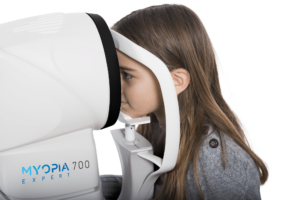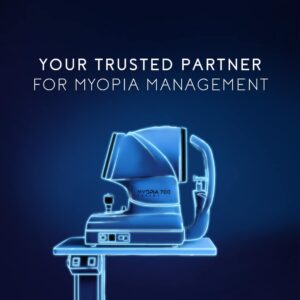At LS Pascual Optical, we understand the importance of preserving your child’s vision for the future. Myopia, also known as nearsightedness, is a common refractive error affecting millions of children worldwide. Left untreated, myopia can progressively worsen over time and, in severe cases, lead to serious visual impairments.
What Is Myopia?
Myopia occurs when the eye grows too long, causing light entering the eye to focus in front of the retina instead of directly on it. As a result, distant objects appear blurry. Myopia is typically diagnosed in children between the ages of 6 and 14, and its severity can increase during adolescence. According to the World Health Organization (WHO), by 2050, nearly half of the global population will be myopic, with millions at risk of developing complications such as retinal detachment and glaucoma (World Health Organization, 2016).
Risk Factors for Myopia
Several factors increase a child’s likelihood of developing myopia, including:
- Genetics: Children with myopic parents are at a higher risk (Walline et al., 2004).
- Age: Myopia often begins in childhood and worsens during periods of rapid growth (Williams et al., 2008).
- Ethnicity: Children of Asian descent are at a higher risk (Feng et al., 2020).
- Excessive Screen Time: Extended use of digital devices, especially up close, is linked to a higher risk of myopia (Morgan et al., 2012).
- Limited Outdoor Time: Studies suggest that children who spend less time outdoors are more likely to develop myopia (Wu et al., 2016).
Our Myopia Management Program
At LS Pascual Optical, we offer a comprehensive Myopia Management Program designed to slow the progression of myopia and safeguard your child’s vision. Our primary intervention is myopic defocus lenses, which have been proven to help manage myopia. These lenses work by creating a defocused image on the retina, which has been shown to slow the elongation of the eye and reduce myopia progression (Walline et al., 2015).
We offer the following myopic defocus lenses:
- MiyoSmart by Hoya: A state-of-the-art lens that uses DIMS technology to help
control myopia progression (Hoya Vision Care, 2020). - Myocare by ZEISS: These lenses are designed to slow myopia progression while
providing superior comfort (ZEISS, 2020). - Stellest by Essilor: A groundbreaking lens that reduces myopia progression by
up to 60% through a unique optical design (Essilor, 2020).
Why Choose LS Pascual Optical?
At LS Pascual Optical, we use state-of-the-art equipment to ensure your child receives the best possible care. Our clinic is equipped with advanced diagnostic tools such as a corneal topographer and biometer. These tools allow us to monitor your child’s eye health and track the effectiveness of our myopia management treatments over time.


Benefits of Early Myopia Management
- Prevents Worsening Vision: Our program helps slow down the progression of myopia, reducing the risk of more severe eye conditions later in life (Jampolsky, 2011).
- Improves Quality of Life: By managing myopia early, your child can enjoy clear vision and participate in daily activities like reading, sports, and outdoor play.
- Customized Treatment Plans: We tailor our myopia management approach to each child’s unique needs, ensuring the most effective care.
Protect Your Child’s Vision Today
If you’ve noticed that your child is squinting, complaining of blurry vision, or holding books or screens too close, it might be time for an eye exam. Myopia is manageable, especially when detected early. Enroll your child in our Myopia Management Program today, and help them enjoy a brighter, clearer future.
Schedule and eye exam with us today, and take the first step in protecting your child’s vision for the years to come.
References:
1.World Health Organization (2016). Global prevalence of myopia and high myopia and temporal trends from 2000 to 2050. Ophthalmology, 123(5), 1036-1042.
2.Walline, J. J., Lindsley, K., & Vedula, S. S. (2004). Myopia Control with Bifocal or Multifocal Lenses. Cochrane Database of Systematic Reviews.
3.Williams, K. M., Verhoeven, V. J., & Cumberland, P. (2008). Myopia. The Lancet, 372(9652), 1300-1309.
4.Feng, Y., He, M., & Zheng, Y. (2020). Myopia prevalence and risk factors in Chinese children. The Lancet Global Health, 8(7), e929-e937.
5.Morgan, I. G., Ohno-Matsui, K., & Saw, S. M. (2012). Myopia. The Lancet, 379(9827), 1739-1748.
6.Wu, P. C., Tsai, C. L., & Yang, Y. H. (2016). The effects of outdoor activity on the prevention of myopia. BMC Ophthalmology, 16, 9.
7.Walline, J. J., & Coats, D. K. (2015). Myopia control with contact lenses. Contact Lens and Anterior Eye, 38(6), 340-346.
8.Hoya Vision Care (2020). MiyoSmart: The Future of Myopia Management.
9.ZEISS (2020). Myocare: Slowing Myopia Progression in Children.
10.Essilor (2020). Stellest by Essilor: Reducing Myopia Progression by 60%.
11.Jampolsky, A. (2011). Myopia Prevention and Control: Current Techniques and Future Directions. Eye Care Journal, 31(3), 111-115.